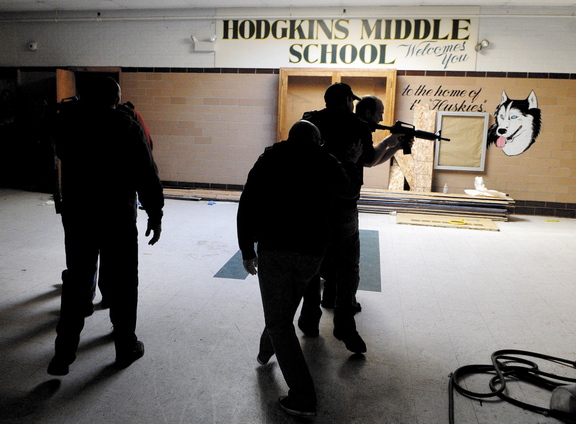AUGUSTA — Two police officers made their way carefully down the school hallway, peering down the barrels of their plastic imitation automatic rifles, checking each closet and room as they passed.
Firefighters walking behind the officers came armed with tourniquets and bandages to aid the “victims” who lay “dying” in the hall.
As the officers stood guard, the paramedics worked quickly to stop the bleeding and drag the victims to a safe room where they would receive more intensive care.
Just days after a Nevada school shooting left a teacher dead and two students badly wounded, Augusta firefighters and police spent Thursday afternoon training in techniques to reach the wounded more quickly in case such an event ever happens in the city.
This time, the setting was the vacant Ella R. Hodgkins Middle School on Malta Street, and the victims were firefighters themselves.
“There’s no time,” Augusta Fire Chief Roger Audette said. “You have a short window to save someone’s life. This type of training is critical.”
Paramedic response times to school or public shootings historically have been agonizingly slow as rescuers were forced to wait outside the danger zone until law enforcement could eliminate the threat. In a situation where every second could mean the difference between life and death, responders have had to wait minutes, and, as in the 1999 Columbine High School massacre, sometimes hours before they could begin treating the wounded.
Rescue agencies have responded by introducing training that allows them to render aid more quickly. That effort has included both increased medical training for law enforcement officers, and training rescue workers to go with police into an area of the building believed to be secure, while the incident is still unfolding. The Augusta Fire Department is the first in the state to offer such training agencywide.
“Under armed protection we can go in with them and start treating people,” Deputy Fire Chief David Groder said.
Firefighters spent two days training in tactical combat casualty care before Thursday’s exercise at Hodgkins School.
In addition to the training, Augusta firefighters will be equipped with bulletproof vests, helmets and eye protection.
The training was designed to be as realistic as possible, including one station that included an uncooked roast hooked by hoses to a pump that filled a small opening with fake blood. The paramedics used the roast to simulate stuffing gauze into the wound to stop bleeding.
“This is as close to the real thing as you can get,” Groder said.
Elsewhere, such training already has paid off, most recently after Monday’s shooting at Sparks Middle School in Reno, Nev.
Emergency medical technicians who responded to the shooting had received tactical training that allowed them to enter the school with police, according to a new report filed by Reno NBC affiliate News 4. The EMTs were able to reach the victims more quickly, provide immediate care and move them to a safe location.
Groder said the training his department received is based on military programs.
“We do fire suppression. We do (hazardous material),” Groder said. “This is just something else we can do.”
Brian Chamberlin, of Atlantic Partners EMS, which provided the training, said the school exercise is crucial for firefighters and law enforcement to learn how to work as a team.
“Everyone needs to talk in the same language,” Chamberlin said. “Those seconds count.”
Groder said he hopes training will continue with Augusta police, as well as the Kennebec County Sheriff’s Office, which had members observe Thursday’s training, and Maine State Police.
“We have to understand what they do,” Groder said, “and they have to understand what we do.”
Chamberlin said the skills the firefighters take away would work not just in a school shooting, but in virtually any mass-casualty event.
“We’ve learned from all these events,” Chamberlin said, referring to the Nevada shooting and last year’s massacre at Sandy Hook Elementary School in Newtown, Conn. “If we were to have an event in this area, we’re better prepared today than we would have been a day ago.”
Craig Crosby can be contacted at 621-5642 or at:ccrosby@centralmaine.com
Send questions/comments to the editors.


